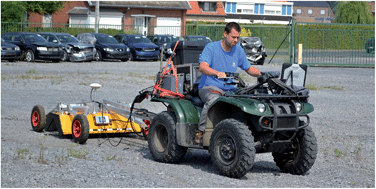Urban soil exploration through multi-receiver electromagnetic induction and stepped-frequency ground penetrating radar
Abstract
In environmental assessments, the characterization of urban soils relies heavily on invasive investigation, which is often insufficient to capture their full spatial heterogeneity. Non-invasive geophysical techniques enable rapid collection of high-resolution data and provide a cost-effective alternative to investigate soil in a spatially comprehensive way. This paper presents the results of combining multi-receiver electromagnetic induction and stepped-frequency ground penetrating radar to characterize a former garage site contaminated with petroleum hydrocarbons. The sensor combination showed the ability to identify and accurately locate building remains and a high-density soil layer, thus demonstrating the high potential to investigate anthropogenic disturbances of physical nature. In addition, a correspondence was found between an area of lower electrical conductivity and elevated concentrations of petroleum hydrocarbons, suggesting the potential to detect specific chemical disturbances. We conclude that the sensor combination provides valuable information for preliminary assessment of urban soils.


 Please wait while we load your content...
Please wait while we load your content...